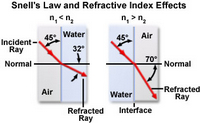|
The idea of routing light (or more precisely, the routing of photons behaving in wave fashion that make up the
visible portion of electromagnetic radiation
) began with the study of
refraction
--the changing or bending of a wave's direction when it passes from one medium to another.

Per 15th century Dutch mathematician
Willebrord Snellius
(among a few others before him), this bending happens up to a "critical angle". Once reached, waves no longer bend but get reflected
back inward.
End emitting fiber optic cable is designed to take advantage of this fact. Light entering refracts
beyond
 this maximum angle which keeps it moving within the cable until its end is reached.
this maximum angle which keeps it moving within the cable until its end is reached.
Side emitting fiber optic cable, a cable that glows similar to
NEON gas tubes,
also operates on this same principal. The difference being that this type of cable allows a portion of light to be "spilled" outward along the way to its end.
Because nearly nothing in the physical world is 100% efficient, the practical result of routing light through fiber strands is brightness exiting
a cable is primarily dependent on total length. Typically good
quality PMMA acrylic material cables
will transmit a high percentage of the incoming light to over 50ft in distance --side emitting cable over 100ft when using light sources "pumping" from both ends.
At a high level, lighting via fiber has the following attributes:
- Lighting a target requires simply routing a flexible fiber cable with focusing lens at its end (50-100ft max)
- Application of light can be directional to a target or emitting to its side for full length of cable
- Fiber cable is virtually unbreakable and highly durable (20+ years)
- A single source lamp coupled to separate fiber cables can light many targets at once
- Fiber systems are energy efficient since a single light source (also efficient in of itself) can illuminate many targets at once
- Color changing light is easily done by the addition of a color filter at source
For more on fiber optic system versatility, technical highlights, and basic
physics of total internal reflection which makes "piping light" at all possible,
see below.
|